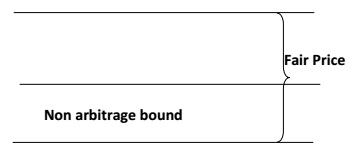Hello,
Futures pricing depends on the characteristics of the underlying asset. There is no single way to price futures contracts because different assets have different demand and supply patterns, different characteristics and cash flow patterns.
Cash and Carry model for Futures Pricing:
It is also known as arbitrage model. The assumption of the model is that in an efficient market, arbitrage opportunities cannot exist.
In other words, the moment there is an opportunity to make money due to mispricing in asset prices across different prices, arbitrageurs will start trading to profit from this mispricing thereby eliminating these opportunities.
Lets understand with an example. Practically, a futures position in a stock can be created in following manners:
- enter into a futures contract, or
- create a synthetic futures position by buying in the cash market and carrying the asset to future date.
The price of acquiring the asset as on future date in both the cases should be the same, i.e. cost of synthetic futures contract(spot price + cost of carrying the asset from today to the future date) should be equal to the price of present futures contract.
If prices are not the same, then it will trigger arbitrage and will continue until prices in both the markets are aligned.
The cost of creating a synthetic futures position is a fair price of futures contract. Fair price of futures contract adds up the spot price of underlying asset and cost of carrying the asset
from today until delivery. Cost of carrying a financial asset from today to the future date would entail different costs like transaction cost, custodial charges, financing cost etc.
Lets take an example from the bullion market.
The spot price of gold is Rs.20,000 per 10 grams. The cost of financing, storage and insurance is Rs.100/10gms. You purchase 10gms of gold from the market at Rs.20k and hold it for 3 months.
We can say that the value of gold after 3 months would be Rs.20,100/10gms.
Lets say the 3 month futures contract on gold is trading at Rs.20,150/10gms. One will attempt to exploit the arbitrage opportunity in the gold market by buying gold in the cash market and selling 3 months gold futures simultaneously. We take delivery og gold in the cash market today, hold it for 3 months and deliver it in the futures market on the expiry of the futures contract. The result will be a profit of Rs.50 without any risk.
This mispricing leads to more people coming to the cash market to buy gold and sell gold in the futures market as a result of which spot gold price will go up and gold futures price will come down.
This arbitrage opportunity continues until the prices between cash and futures market are aligned. Therefore, if futures price is more than future fair price of asset, it will trigger cash and carry
arbitrage, which will continue until the prices in both the markets are aligned.
Also, if futures prices is less than the future fair price of asset, it will trigger reverse cash and carry arbitrage.
Cost of transaction and non-arbitrage bound:
Cost components of futures transaction like margins, transaction costs, taxes etc create distortions and take markets away from equilibrium. In fact, these cost components create a non-arbitrage bound
in the market i.e. if the futures price is within that bound around the future fair value, arbitrage will not take place.

Practically, every component of carrying cost contributes towards widening this non-arbitrage bound. Hence, for markets to be efficient, costs of operating in the markets should be as low as possible. Lower costs would narrow down the non-arbitrage bound, which in-turn would ensure the efficient price alignment across the markets.
Extension of cash & carry model to the assets generating returns
If inflows like dividend on equity and interest on debt occur during the holding period of underlying assets, they are adjusted in the future fair price. Thus modified formulae for future fair price or synthetic futures price is:
Fair price = Spot price + Cost of carry - Inflows
Assumptions in cash and carry model:
- underlying asset is available in abundance in cash market
- demand and supply in the underlying asset is not seasonal
- holding and maintaining of underlying asset is easy and feasible
- underlying asset can be short sold
- no transaction costs
- no taxes
- no margin requirements
Convenience yield:
This is applicable when inflows are intangible. Intangible inflows essentially mean values perceived by the market participants just by holding the asset. These values may be in the form of just convenience or perceived mental comfort holding the asset.
If there is a natural disaster like flood in a particular region, people start storing essentials like grains, vegetables, and energy products like heating oil. As a human tendency, we store more than what is required for real consumption during a crisis. If every person behaves similarly, then suddenly there is demand for the asset in the cash market. This increases the price of the underlying asset. Here, people derive convenience by just holding the asset.This is called convenience return/yield.
Convenience yield sometimes may dominate the cost of carry, which leads futures to trade at a :. Even reverse arbitrage is not possible because no one lends traders the assets to sell short in cash market. Practically, here the cash and carry model breaks down and cannot be used to price the underlying
asset.
Cheers!